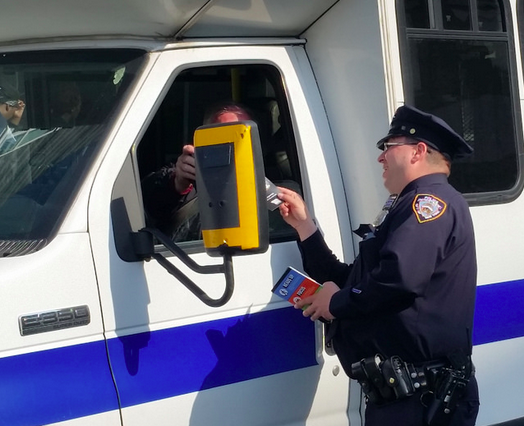Each year, the City Charter requires the mayor to issue a report showing whether city agencies are meeting their goals. This year's report card is a mixed bag for street safety, DOT, and NYPD. While fatalities are down, the direction of the enforcement and street design policies behind Vision Zero is less clear.

The document, called the Mayor's Management Report, gathers data for each fiscal year. The latest edition covers fiscal year 2015, which ended June 30.
During that period, traffic fatalities declined 13 percent compared the year before, including a 20 percent drop for motor vehicle occupants and an 8 percent drop for pedestrians and cyclists. Only fiscal year 2011 saw fewer traffic deaths. (The report does not measure serious injuries, which are subject to less statistical noise than fatalities.)
NYPD issued 4 percent fewer traffic tickets last year, but 11 percent more summonses for "hazardous violations," which include failing to yield to pedestrians, improper turns, double parking, and running red lights. Still, police issued slightly more hazardous violations in 2011 than last year [PDF].
Tickets for using a cell phone while driving fell 11 percent last year to 125,787, continuing a downward trend from a peak of 231,345 in 2010 [PDF]. Interestingly, the report says the "desired direction" for hazardous violations and cell phone summonses is "neutral" rather than "up."
Moving violations issued by the Taxi and Limousine Commission to for-hire drivers jumped 113 percent last year to 10,738, and cell phone violations increased 25 percent to 5,690 tickets. At the same time, summonses for unlicensed for-hire operation fell 16 percent to 12,497 [PDF].
The police made 8,155 drunk driving arrests, down from the previous two years. Last year, 31 people died in DUI crashes, also down from the previous two years but up from 2011 and 2012.
The city aims to install 50 miles of bike lanes each year. Last year, it installed 51 miles, down from 66 miles the year before but almost the same amount as in FY 2013 and significantly more than the numbers posted in 2011 and 2012. However, the report does not distinguish between protected bike lanes, painted bike lanes, and sharrows.
DOT also installed 2,408 bike racks, above the target of 1,500 but below the numbers for 2013 and 2014 [PDF].
The city created an additional 230,956 square feet of pedestrian space last year, including plazas, curb extensions, sidewalks and refuge islands. That's down from 297,408 square feet the year before and a record 360,057 square feet in 2013, but about on par with the amount installed in 2012. There are 49 plazas open to the public, with 22 in planning, design or construction.
DOT also installed 388 street benches, 208 leading pedestrian intervals, 3,168 speed limit signs, and a record 382 speed humps.
Select Bus Service ridership continued to climb, hitting 45.2 million trips last year, as the city added new routes. But the pace of expansion has slowed: DOT added only four new miles of SBS routes last year, after adding at least 20 miles each year in 2013 and 2014. The most recent SBS additions were on the M86 and M60 routes, with Utica Avenue, Woodhaven Boulevard, and a route from Flushing to Jamaica set to launch soon.
Citi Bike's annual memberships dropped 21 percent from the year before, from 92,598 to 73,369, and the total number of trips fell from 9.4 million to 8.8 million. DOT attributes the drops to harsh winter weather and an increase in membership fees from $95 to $149 last October. Frustration with the system's reliability, has only begun to turn around in recent months, may also have been a factor. Citi Bike reports that ridership has been increasing lately, in part due to system expansion.





